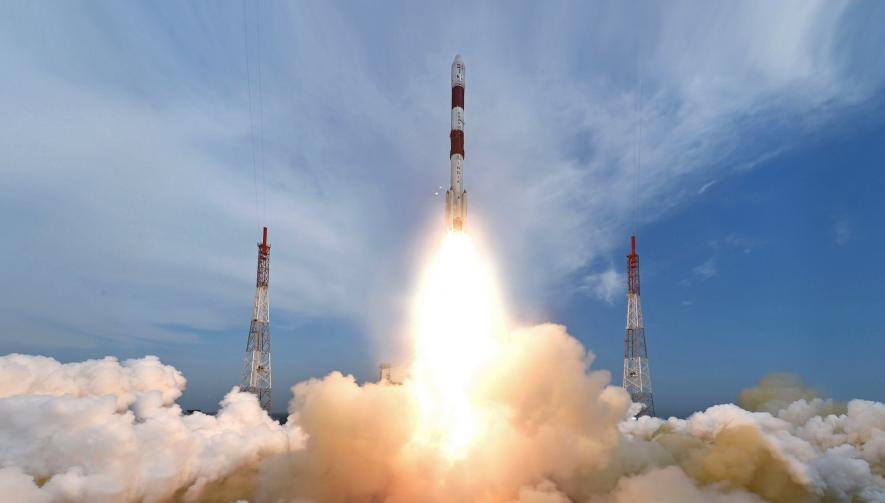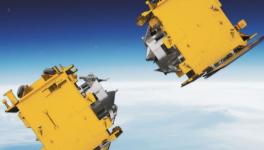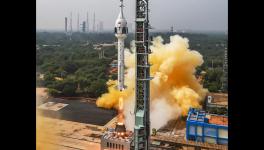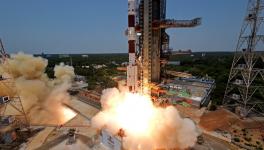ISRO’s Record Launch: Less Known Innovations

ISRO’s record launch: less known innovations
India last week once again breathlessly celebrated another record-breaking feat by the Indian Space Research Organization (ISRO) in launching 104 satellites on a single flight of its Polar Satellite Launch Vehicle (PSLV) C-37 on 16 February 2017. Print and electronic media in India went ga-ga with stories about how India had pulled off another “first,” beating by several times the earlier Russian record launch of 37 satellites in a single flight in 2014. However, in the overwhelming euphoria of an Indian record in an advanced technology, innovations in the satellites themselves and their significance as regards emerging trends in satellite and launch technologies, went mostly unnoticed. Also, while there was some coverage, especially in international media, of the significance of the launch for India’s place among other space-faring nations, the audience was not left much the wiser as to the connotations for the future of ISRO.
ISRO’s achievement There is undoubtedly considerable justification for satisfaction if not pride in ISRO’s achievement. This was the 38th successive successful PSLV launch and the 15th using the heaviest lift XL version since its debut with the lunar probe Chandrayaan-1 in 2008. All satellites carried by C37 were successfully and accurately placed in their designated sun-synchronous orbits (SSO) and relative positions.
Space scientists and engineers, however, understand that ISRO’s achievement is commercial more than technological. This was confirmed by statements by the Chairman ISRO who said low cost and reliability of the launch services were the main achievement. The release of so many satellites at one go did not really involve any new or innovative technology, although it did testify to the capability and professionalism of ISRO personnel. One novel and interesting technical development in C37 was its use of the constellation of satellites in the Indian Regional Navigation Satellite System (IRNSS) to track and help guide the orbits of the different satellites launched, instead of the US-based Global Positioning System (GPS) which it usually uses.
The low cost of ISRO’s launch services is another and important factor contributing to its making a mark in the crowded and under-supplied global launch market. An ISRO PSLV launch is estimated to cost around $15 million (about Rs.100 crores) compared to about $100m for launches by a US Atlas V, European Ariane-5, Japanese H-IIA or a Chinese Long March, while even the cheaper Russian Proton launcher would cost around $68m and Elon Musk’s highly cost-competitive private sector Falcon 9 (whose first stage is reusable, but which is still having considerable teething troubles as seen in the weekend’s uncertainties with its latest launch to the International Space Station) about $57 million.
Taking cost and efficacy together, ISRO has thus once again proved the reliability of the PSLV rockets and accompanying satellite launch systems. This is evidenced by the recourse to ISRO’s C37 launch by two commercial US users, who accounted for 96 of the 101 international co-passenger satellites on board, both of whom are repeat users.
Even before the C37 mission, ISRO had cemented its position in the commercial market. So much so that several of the new private sector launch companies in the US even banded together towards the end of the Obama administration to demand some action against ISRO on the grounds that Indian state support and subsidies to ISRO are unfairly undercutting competition and undermining the US launch companies. However, this is mainly a heritage problem, since all countries adopted the NASA and Soviet state-funding models and mostly continue to do so. Nevertheless, ISRO would do well in the coming months and years, particularly during the highly protectionist Trump presidency, to rationalize its costing practices, especially to clear doubts about how it factors-in manpower costs into the pricing of its services.
ISRO in the global market The media hype in India has also overstated the contention that ISRO has now staked claim to a sizeable share of the “$300 billion global market.” While ISRO has undoubtedly established itself as a major player in the launch business, its market position needs to be seen correctly and in perspective.
ISRO’s PSLV rockets enable it to launch satellites of around 1500kg in low-earth orbits (LEO) or sun-synchronous orbits of around 600km, with payload capacity going up to about 1800kg with more powerful variants. Satellites in such orbits are used mainly for earth observation such as remote sensing and military surveillance applications. But this capability only covers a small proportion of total commercial launches worldwide.
The total launch industry itself is worth only around $5.9 billion annually out of total annual space business of about $200 billion, revenues from all satellite services combined amounting to around $123 billion. Of this, earnings from earth observation services are a mere $1.6 billion per year, a very small fraction of earnings from TV, telephony, communications and other consumer-oriented services. Further, earth observation satellites and other satellites of similar size and orbital profiles constitute under 20% of all satellites in operations, an increasing number of which are really small “nano-satellites” calling for large numbers to be launched on a single rocket as in PSLV C37. In 2014, such nano satellites constituted 63% of all satellites launched. If India does indeed manage to carve out for itself a niche market in this segment for launch of small satellites, it would be creditable indeed.
However, seen from a commercial angle, ISRO will remain at least for some time a minor player in the global launch market, itself a small fraction of the total space business. This will remain true until ISRO’s GSLV (Geo-synchronous Satellite Launch Vehicle) --- which has so far undergone just two consecutive successful launches, the bare minimum required for even being considered a viable system --- achieves roughly the same level of reliability as the PSLV and can enter the market for larger satellites at higher orbits as required for communications. ISRO is also developing, slowly, a re-usable launch vehicle, looking very much like NASA’s space shuttle and designed to glide through the atmosphere and land like an aircraft. Elon Musk’s SpaceX has already staged multiple launches of its re-usable Falcon 9 rocket which lands vertically just as it took off.
In 2014, out of a total of 20 satellite launches booked commercially, 19 were for flights to Geo-Stationary Orbits and only 1 for LEO flights. Arianespace currently commands around 50% market share in the former category and is already facing considerable heat from SpaceX which is posing a serious challenge to traditional State-supported launch companies.
None of this takes away from ISRO’s achievement or the broad thrust of India’s space programme which has, rightly for the latter half of the 20th century, focused on launch capability and applications for societal benefit such as earth observation or remote sensing. Even China Daily, normally not given to praise of its neighbour to the South, stated that other developing countries had a lot to learn from India’s space programme, especially its application orientation and low-cost launch capability which had enabled it to make a mark in the global commercial launch market.
Nano Satellites: glimpses of the future The really interesting aspect of C37 lies in the technology and intended use of the 101 international co-passenger satellites, especially the 96 from two US commercial entities. These satellites demonstrate a growing trend in satellite technology, with implications for launch services, which may well be an indication of things to come and of innovations in space technology.
The striking aspect common to all the non-ISRO co-passenger nano satellites is that they all conform to the CubeSat standard or format. CubeSats are a particular type of miniaturized satellite, initially conceived for conducting academic and applications research at lower costs than in the large satellites commonly used in the industry. CubeSats are configured in multiples of 10x10x11.35 cm (centimeters), mostly using available off-the-shelf electronic and structural components. Its standard 10x10 cm square base dimensions allows for design of a standard rail and spring-loaded system for easy launch from spacecraft without designing of special buses for each launch.
These specifications were evolved in 1999 by a team comprising engineers at the California Polytechnic State University (Cal Poly) and Stanford University so as to promote the skills required for design, manufacture and testing of small satellites intended for Low-Earth Orbits (LEO) that could conduct research and explore innovative technologies. Most CubeSats launched till 2013 were from academic institutions, whereas that year about half the total launches were for commercial purposes and in 2014 most CubeSats launched were commercial, start-up or amateur. Manu CubeSats in the US have been funded through crowd-sourcing campaigns through platforms such as Kickstarter, the New York based company that raises public funds for innovative projects.
On PSLV C37, the university and student satellites from Israel’s Ben Gurion University, Kazakhstan’s Al-Farabi Kazakh National University, and UAE’s American University of Sharjah (AUS), are all based on the CubeSat standard.
88 “Dove” imaging satellites of Planet Inc of USA conforming to 3U CubeSat standard, i.e. 10x10x30cm, weighing 4.7kg each (compared to traditional commercial imaging satellites) and collectively known as Flock 3p, were launched on C37. These followed an earlier launch of 12 similar Flock 2p satellites by ISRO’s C34 in June 2016. Starting in 2001, Planet now has its full constellation of 144 Satellites forming a ring around earth in sun-synchronous orbit at 500km altitude. With this, Planet has achieved its ambitious goal of imaging the entire landmass of earth everyday, enabling clients to acquire images at chosen resolution in the 3-5m range, location, subject of interest, resolution, including archives, relating to climate monitoring, crop yield prediction, urban planning, infrastructure and disaster response. Along with ISRO’s own record on C37, Planet Inc now holds the record for the largest private constellation of satellites.
Audio rather than imaging The 8 “Lemur-2” satellites of Spire Inc of USA launched by C37 are even more interesting. The Lemurs are also based on the 3U CubeSat standard, and follow up from an earlier ISRO launch of 4 Lemur-2s in September 2015, the first time ISRO was used for launching US commercial CubeSats. The C37 launch brings the constellation of Lemur-2s to 29, aiming for a total of 125 with monthly launches. Spire’s storage spaces are full of satellites, but the limiting factor is timely availability of less expensive launch dates.
More than the numbers, the innovation in the Lemur-2 satellites is that, unlike most satellites that are focused on imaging, the Lemurs focus on tracking radio or audio signals through multiple sensors. One set tracks ships and other cargo carriers equipped with GPS signaling and Automatic Identification Systems (AIS), ultimately aiming for a theoretically universal coverage of all ships, trains, trucks etc plying on earth. Users would be cargo companies, insurance companies, trade monitoring agencies, military and spy agencies looking to track, monitor and regulate asset movement, illegal fishing, piracy, search and rescue, etc.
Each satellite also carries a meteorological payload called STRATOS which uses GPS radio occultation (GPS-RO), i.e. the tracking of signals from GPS satellites and their temporary blockage by other objects in space, to provide highly accurate data on temperature, humidity, atmospheric pressure, wind speeds etc used for weather and climate change monitoring, prediction and modeling. With this, Spire Inc has become the largest private provider of weather data and has also secured a landmark long-term contract from the US National Oceanic and Atmospheric Administration (NOAA) for the same. Spire now aims to become the leading provider of super-accurate, timely and complete planet-covering weather data.
The CEO and prime mover of Spire Inc and its idea of making a business using GPS-RO and miniature satellites, Peter Platzer, speaks of the “trifecta of forces” that was re-shaping the space industry since the 1990s, namely, cash-strapped governments cutting back on space budgets, private sector and other new and innovative initiatives, and the rapid development of miniaturization of technologies as typified by the smart phone. One of the major venture capital partners of Spire wrote in a published 2014 paper that "most every satellite in orbit is a floating dinosaur…, a bloated, one-off, expensive, often militarized, monolithic relic of the mainframe era." Nano satellites, particularly the CubeSats allowing for incorporation of off-the-shelf components and costing a very low $1 million each, provided the ideal platform.
Innovation in space technology is gathering pace, with many new players bring many new ideas to the table. So far, ISRO has focused on developing its rocket technology and improving its launch capability, apart from working on the older generation large satellites. If ISRO wants to stand out in an increasingly crowded market, it needs to re-examine its future research programmes and develop applications that can command a larger share in commercial user services. Its own vision and choice of future trajectory will determine if they can succeed in innovations that can break barriers. But they also require far greater support from the Government which today keeps ISRO on a starvation diet in terms of funding, forcing it to use even its commercial earnings for research. This betrays a highly short-sighted outlook on the part of the Government, and a lack of understanding of the role and potential of R&D.
Disclaimer: The views expressed here are the author's personal views, and do not necessarily represent the views of Newsclick
Get the latest reports & analysis with people's perspective on Protests, movements & deep analytical videos, discussions of the current affairs in your Telegram app. Subscribe to NewsClick's Telegram channel & get Real-Time updates on stories, as they get published on our website.






















